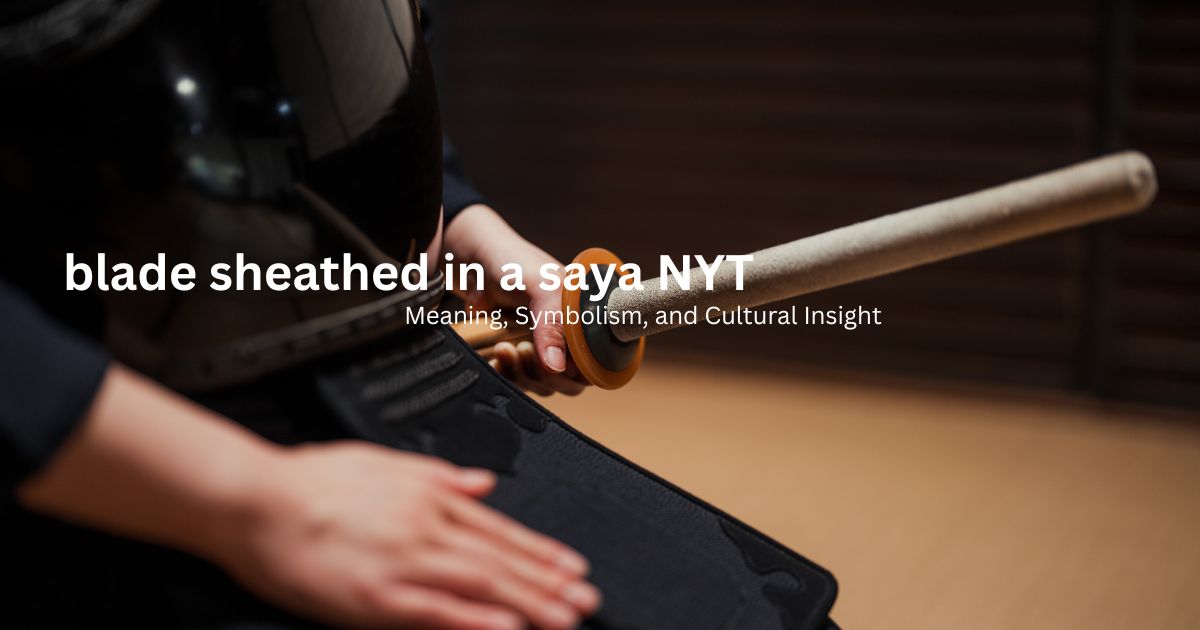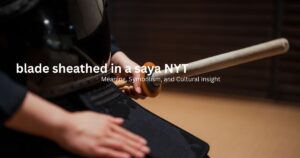Blade Sheathed in a Saya NYT – Meaning, Symbolism, and Cultural Insight
At first, the expression Blade sheathed in a saya NYT could appear strange. Particularly with regard to samurai swords and their metaphorical significance, the saying finds its origins in Japanese culture and history. Often constructed of wood and intended not just to guard but also as a representation of readiness, honor, and moderation. We’ll examine in this essay what this saying means, its cultural importance, its modern interpretations, and why it has attracted press coverage. like The New York Times (NYT).
What is a Saya?
The traditional wooden scabbard used to enclose Japanese swords including the katana, wakizashi, and tanto is a saya. Usually lacquered for attractiveness and longevity. Beyond simply a case, it stands for the equilibrium between power and control since the sword symbolizes sharpness and force whereas the saya denotes discipline and patience.
The Symbolism of a Blade in a Saya
Strength Under Control
Restricted power is symbolized by a blade sheathed in a saya. The sword is capable of great damage, but when hidden it shows the warrior’s self-control in resisting indiscriminate usage.
Peace over Violence
In Japanese society, a sheathed blade typically represents choosing peace above avoidable war. Besides military training, samurai received ethical discipline.
Readiness and Protection
Keeping the blade in a saya helps one to be ready to act when necessary. It helps the warrior to be always battle-ready and shields the blade from damage.
Historical Significance in Samurai Culture
The samurai treated their swords as an extension of their soul. The saya was more than a container—it was part of the ritual. The way a samurai drew and re-sheathed the sword was deeply tied to bushido, the way of the warrior.
-
Drawing the blade (Nukitsuke) – Represented decisive action.
-
Resheathing (Nōtō) – Symbolized closure, discipline, and respect.
Thus, the imagery of a blade sheathed in a saya evokes deep connections to honor, morality, and discipline.
Modern Interpretations of Blade Sheathed in a Saya NYT
Philosophical Perspective
The idiom is sometimes interpreted metaphorically in modern usage. It may characterize someone who has enormous capacity, ability, or power but chooses to practice patience and restraint.
Business and Leadership
Leaders may be compared to a sheathed blade—having the ability to act decisively but choosing diplomacy and wisdom until action is absolutely necessary.
Personal Growth
On a personal level, it could stand for knowledge of when to act and when to remain quiet, or self-control. Often, a person’s intelligence is shown in what they decide not to do rather than in what they are capable of.
Why the New York Times Mentions It
Often emerging in reference to literary debates, cultural characteristics, or metaphorical interpretations released by The New York Times, the phrase blade sheathed in a saya NYT arises. In several pieces, the NYT has emphasized Japanese culture, martial arts, and symbolic significance; this phrase seems part of more profound narrative.
Cultural Representation in Media
Films, anime, and books often employ sheathed knife imagery. Characters like samurai or contemporary warriors are shown with swords resting quietly in their saya, symbolizing power hidden beneath calmness. For instance, in movies like The Last Samurai, the act of blade sheathing usually signals the end of strife.
Blade and Saya in Martial Arts
Central in martial arts like Iaido is the action of withdrawing and sheathing the blade. Handling the blade with accuracy, patience, and elegance mirrors the equilibrium between strength and control.
Metaphor in Daily Life
Think about times when you could argue but choose silence instead. Or moments when you have the ability to fight but decide to forgive. That’s the modern-day blade in a saya—strength that is present but not misused.
Saya as an Art Form
The saya itself is often handcrafted with fine details, sometimes decorated with lacquer, metal fittings, or intricate designs. This artistry represents the fusion of functionality and beauty in Japanese culture.
Lessons We Can Learn
-
Restraint is power.
-
Peace is stronger than aggression.
-
Preparation matters as much as skill.
-
Wisdom lies in knowing when to act.
Conclusion
The phrase ” blade sheathed in a Saya ” is far more than just a simple description of a sword in its sheath. It shows discipline, balance, and knowledge—fundamental principles found in Japanese society yet still very pertinent today. Whether in leadership, personal development, or everyday decisionmaking, the concept reminds us that real strength is not about continual exhibition of force but about knowing when to show it and when to keep it hidden.
FAQs
1. What does “blade sheathed in a saya” mean?
It refers to a Japanese sword encased in its scabbard, symbolizing restrained power, discipline, and peace.
2. Why is the saya important in samurai culture?
The saya protected the sword and was part of samurai rituals, symbolizing honor, respect, and readiness.
3. How is the phrase used metaphorically today?
It describes individuals with great potential or strength who exercise patience, self-control, and wisdom.
4. What does it mean when the New York Times uses this phrase?
It usually appears in cultural or literary contexts, symbolizing deeper meanings of discipline, strength, and peace.
5. Can the symbolism of the saya apply to everyday life?
Yes, it teaches us that real strength lies in restraint, preparation, and wise decision-making, not reckless action.


1 comment